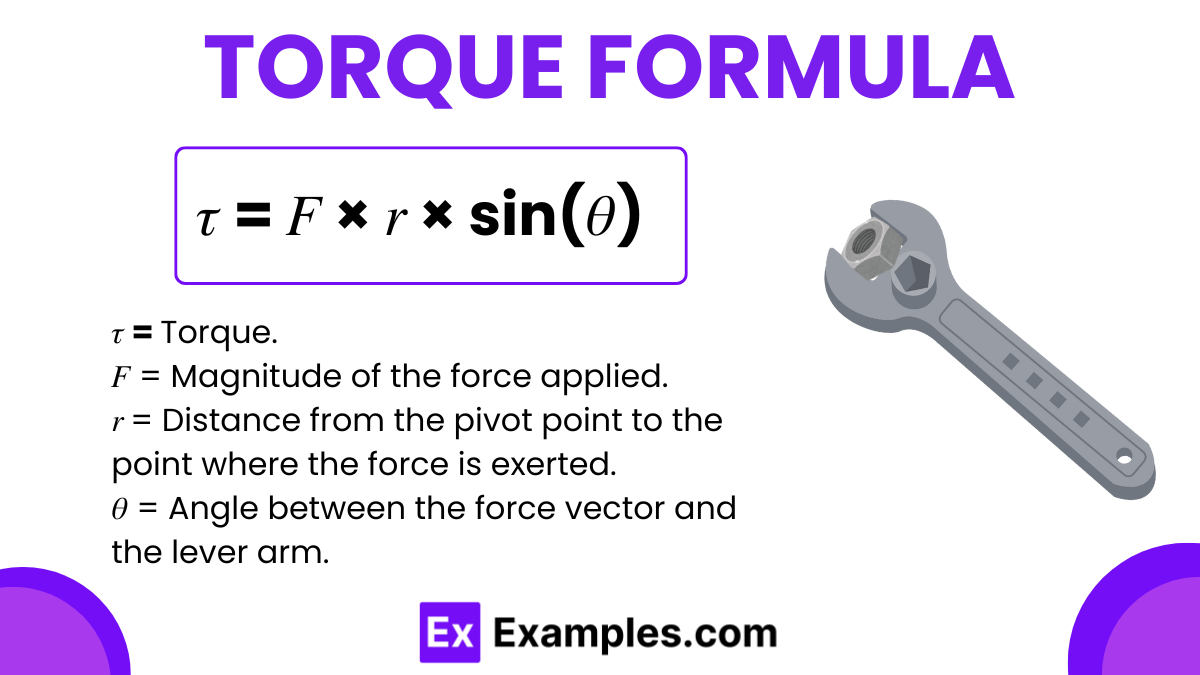Torque = F * r
Torque = F / r
Torque = r / F
Torque = F * r²
Torque = F * r


Torque is a fundamental concept in physics that describes the tendency of a force to rotate an object about an axis, fulcrum, or pivot. Just as a force causes an object to move in a straight line, torque causes an object to rotate. This formula calculates the torque produced by a force applied at a given angle to a rotational point. The torque formula, given below, is essential for analyzing situations involving rotational motion:
The concept of torque was first brought into clear scientific light by Sir Isaac Newton in his foundational works on classical mechanics. Although he did not specifically coin the term “torque,” his laws of motion and revolutionary ideas laid the groundwork for this vital physical quantity. Torque plays a critical role in every rotational motion from the simplest door hinges to the most complex engineering systems like car engines and space stations.
Problem: Suppose you apply a force of 30 Newtons to a wrench at an angle of 90 degrees, and the distance from the pivot point (nut) to where the force is applied is 0.15 meters. Calculate the torque.
Solution: The torque can be calculated using the formula: 𝜏 = 𝐹 × 𝑟 × sin(𝜃) Where:
Since sin(90∘)=1
𝜏 = 30 × 0.15 × 1 = 4.5 Nm
Torque = 4.5 Nm
Problem: How much force must be applied perpendicular to a lever arm of 0.5 meters to produce a torque of 20 Nm?
Solution: Rearrange the torque formula to solve for force: 𝐹=𝜏 / ( 𝑟×sin(𝜃) ) Given:
Since sin(90∘)=1
𝐹 = 20 / ( 0.5 × 1) = 40 N
Force required = 40 N
Problem: A person applies a force of 50 Newtons at an angle of 30 degrees to the horizontal on a spanner. The spanner’s length from the nut to the point of force application is 0.2 meters. Calculate the torque generated.
Solution: Using the torque formula: 𝜏 = 𝐹 × 𝑟 × sin(𝜃)
Where:
Using sin(30∘) = 0.5
𝜏 = 50 × 0.2 × 0.5 = 5 Nm
Torque = 5 Nm
To find torque from RPM, use: 𝜏 = ( 𝑃 × 5252 ) / 𝑅𝑃𝑀, where 𝑃 is power in horsepower.
Calculate torque using 𝜏 = 𝐹 × 𝑟 × sin(𝜃), where 𝐹 is force, 𝑟 is arm length, 𝜃 is angle.
Torque unit: Newton-meter (Nm).
Text prompt
Add Tone
10 Examples of Public speaking
20 Examples of Gas lighting
Torque = F * r
Torque = F / r
Torque = r / F
Torque = F * r²
Torque = F * r
If a force of 10 N is applied at a distance of 2 m from the pivot, what is the torque?
20 Nm
5 Nm
12 Nm
8 Nm
Which of the following does NOT affect the torque produced by a force?
The magnitude of the force
The distance from the pivot
The angle of the force
The speed of the force application
For a given force, how does the distance from the pivot affect the torque?
Torque increases as distance increases
Torque decreases as distance increases
Torque remains constant
Torque first increases then decreases
How is torque affected if the force is applied perpendicular to the lever arm?
Maximum torque
Minimum torque
No torque
Half of the maximum torque
If the angle between the force and the lever arm is 90 degrees, what is the torque formula?
Torque = F * r
Torque = F * r * sin(90)
Torque = F * r * cos(90)
Torque = F / r
What happens to the torque if the force is applied parallel to the lever arm?
Maximum torque
Minimum torque
No torque
Half of the maximum torque
If a torque of 50 Nm is produced by a force of 25 N, what is the distance from the pivot?
1 m
2 m
3 m
4 m
Which unit is NOT used to measure torque?
Nm
lb-ft
dyne-cm
N/m
What is the torque if a force of 15 N is applied at a distance of 3 m from the pivot at an angle of 60 degrees?
45 Nm
30 Nm
39 Nm
23.3 Nm
Before you leave, take our quick quiz to enhance your learning!

